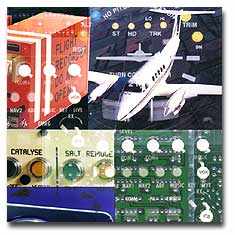Standardization of Avionics Technology Solves Compatibility,
Cost Issues
The growing demand for advanced avionic test systems has
challenged test vendors in the automatic test equipment (ATE)
market. In a bid to align their legacy systems with upcoming
technologies in the line replaceable units (LRU) space, most
vendors are trying to develop newer test program sets (TPS) that
are also compatible with older systems.

Further, with both the commercial and military sectors
increasing budgets for upgrading their avionic systems, vendors
feel that their investments are worth the effort.
New analysis from Frost & Sullivan, World Avionics ATE
Market, reveals that revenue in this industry was estimated at
$1.01 billion in 2003 and is projected to grow to $1.69 billion in
2010.
However, while considering the installation of a new TPS, it is
essential to balance its developmental cost against the cost and
lifecycle of the particular module to be tested.
"The lifecycle of avionics has been on the decline, and some
vendors are of the opinion that the utility of the TPS might not
justify the investment made on it," notes Frost & Sullivan
research analyst Karthik Rajamani. "If the avionics device is cheap
enough to warrant quick replacement, there is no financial sense in
installing an expensive TPS."
 Vendors, therefore, have immediate
need for a TPS that can test avionics modules quickly and cost
effectively. This is further emphasized by the avionics industry's
continued accommodation of cheaper and more easily replaceable
avionic devices.
Vendors, therefore, have immediate
need for a TPS that can test avionics modules quickly and cost
effectively. This is further emphasized by the avionics industry's
continued accommodation of cheaper and more easily replaceable
avionic devices.
A possible solution lies in the standardization of technology.
Large prime manufacturers test their LRUs with in-house systems.
These manufacturers' dominance in the market makes them prime
leaders, and any technology adopted by them is soon likely to be
adopted as the industry standard.
"While it could initially seem threatening, this gradual move
toward standardization is likely to reduce the acquisition costs of
end users and impact the market positively in the long term,"
predicts Rajamani.
Further, standardization is expected to aid avionics ATE vendors
and their end users as they continue to grapple with compatibility
issues and high acquisition costs.
The rising need among end users such as airlines and maintenance
repair and overhauls (MROs) for a common test platform that is
capable of catering to proprietary avionics of different aircraft
manufacturers also necessitates standardization measures.
Further, since the cost of TPS forms a significant portion of
the total ATE cost, end users are now stressing the need to reduce
any incremental costs that might be incurred due to the development
of a new TPS. A series of initiatives has already been successfully
undertaken.
"It is not possible to develop a TPS for every new product being
tested," says Rajamani. "It is, therefore, essential that vendors
develop a common test platform that can be used across a variety of
avionics modules and is compatible with both new and old ATE
systems."
World Avionics ATE Market, part of the Manufacturing Test and
ATE Subscription, assesses the current and future prospects of the
military and commercial avionics ATE market. It critically
evaluates the performance of leading participants in terms of unit
shipment and provides comprehensive insight into the drivers and
restraints affecting the market. Additionally, it outlines
strategies that are likely to assist participants in positioning
themselves. Executive summaries and interviews are available to the
press.
 ANN's Daily Aero-Linx (04.16.24)
ANN's Daily Aero-Linx (04.16.24) Aero-News: Quote of the Day (04.16.24)
Aero-News: Quote of the Day (04.16.24) Airborne 04.10.24: SnF24!, A50 Heritage Reveal, HeliCycle!, Montaer MC-01
Airborne 04.10.24: SnF24!, A50 Heritage Reveal, HeliCycle!, Montaer MC-01 Airborne 04.12.24: SnF24!, G100UL Is Here, Holy Micro, Plane Tags
Airborne 04.12.24: SnF24!, G100UL Is Here, Holy Micro, Plane Tags Airborne-Flight Training 04.17.24: Feds Need Controllers, Spirit Delay, Redbird
Airborne-Flight Training 04.17.24: Feds Need Controllers, Spirit Delay, Redbird




